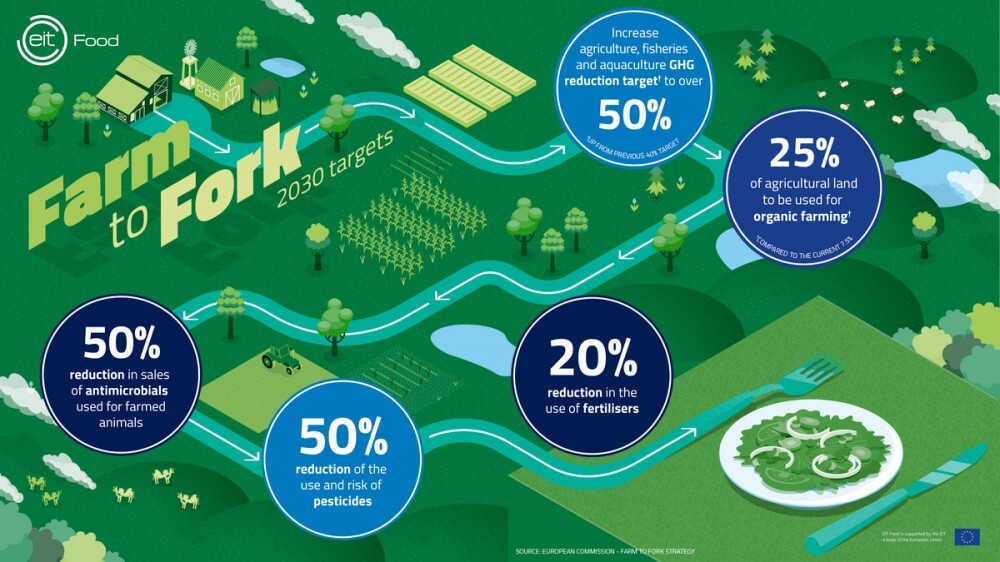The EU Green Deal and its Farm-to-Fork and Biodiversity Strategies stipulate ambitious policy objectives that will fundamentally impact agricultural businesses and value chains. Are these objectives realistic? And how do they fit with the EU’s policies on food security, the internal market, international trade and multilateral economic agreements? As significant conflicts of goals become apparent, the discussion on expectations, preconditions and consequences is now underway.
The Farm to Fork Strategy concretely foresees a reduction of pesticide and fertilizer use of 50% and 20% by 2030, respectively. In addition, 25% of EU’s agricultural land is supposed to be put under organic farming conditions, which generally means a reduction in productivity. Unfortunately, the strategy is less concrete about the important role of innovation in general and plant breeding innovation specifically to compensate for productivity losses and to contribute to a more sustainable agriculture.

On July 25, 2018 the European Court of Justice (ECJ) published its ruling on mutagenesis breeding, including targeted genome editing techniques. This ruling subjected new tools like CRISPR Cas-9 to the EU’s strict rules and requirements for GMOs, and with that effectively prohibited European plant breeders and farmers from utilizing these powerful technologies. These regulatory obstacles are not based on evidence showing that genome editing poses a risk to human health or the environment, but rather on political interference in the regulatory approval process. The COVID pandemic made this abundantly clear. In July 2020, for example, the EU suspended some of its excessive genetic engineering rules to facilitate the development of COVID vaccines, and has since celebrated the approval of these important drugs while trying to prevent the use of biotechnology in agriculture.
Innovation to preserve tradition
Since the discovery of the laws of genetics by Gregory Mendel in 1866, plant breeders have continuously integrated the latest plant biology innovations into their toolbox to develop enhanced crops that help farmers sustainably grow the food we all depend on.
Europe’s seed sector, technology developers and public researchers have always been important actors in this evolving effort and remain global leaders in developing improved plant breeding methods. They work tirelessly to provide farmers with crop varieties that fit the needs of a highly productive and sustainable agriculture system and meet the exacting demands of consumers. It is no secret that these experts understand the value of new breeding techniques (NBTs) like CRISPR and want to employ them.
Contrary to the claim of some environmental groups that genome editing “provides new avenues of control through modifying specific plant traits, most notably insect and herbicide resistance,” industrial applications of this sort are only one aspect of NBT research, and a minor one at that. Our recent survey of 62 private plant breeding companies, 90% of which are small and medium size firms (SMEs), confirms that EU plant breeders are able and willing to use these technologies to develop a wide range of crop species and traits for farmers. From grape vine to wheat, NBTs can generate innovation to protect Europe’s traditional crops from pests and diseases and other threats posed by climate change.
Independent of their size, many companies are already using NBTs in their R&D pipelines for technology development, gene discovery and to produce improved plant varieties. These activities cover a wide range of agricultural and horticultural crops—from the so-called cash crops like maize and soybean to minor crops like pulses, forage crops and chicory—and span a wide diversity of characteristics, including yield, plant architecture, disease and pest resistance, food-quality traits and abiotic stresses like drought and heat.
EU biotech regulations leave SMEs behind
For the majority of SMEs that have their major market within the EU, moving research activities or product focus to non-EU markets is typically not an option. Many of these companies were forced to re-evaluate their NBT research following the 2018 ECJ decision. This included reduction in scope, change of market focus (where possible) and re-evaluation of timelines. In the most unfortunate cases, projects were simply terminated or never even started.
Dutch potato breeder HZPC, for example, was forced to look beyond Europe to get started with these technologies. “That is not what we want,” said Robert Graveland, research director at HZPC, in an interview with FreshPlaza. “We are based in the Netherlands. We consider the Netherlands to be a wonderful, innovative country; certainly in the field of breeding. There are tremendous developments here.”
Given the highly competitive market for strategic agricultural and food investments, the level of uncertainty that exists within the EU has the potential to divert research and development investments away from Europe to markets with more science-based, risk-proportionate, pro-innovation regulations. Uncertainty and irreversibility have had a chilling effect on NBT research, denying consumers and farmers products that could improve their lives and contribute to more sustainable food systems.
Since larger companies generally operate a higher share of R&D facilities outside the EU, it is easier for them to benefit from the use of NBTs for concrete product development outside the EU market, thereby increasing their readiness to restart development for the EU market should the regulatory environment change at a future point. In this respect, the current restrictive regulatory regime in the EU will provide larger companies with a head start if the EU legislation becomes more permissive. The consequence is that SMEs lag behind while large companies continue developing and applying NBTs in other parts of the world with more sensible regulations. Put another way, the EU rules reinforce the concentration in the seed market anti-GMO groups have complained about for decades.
Will the Green Deal become a “no-deal” for plant breeding innovation?
In what may be the most ironic aspect of this whole debacle, NBTs have the potential to support the laudable goals of the European Green Deal and its Farm to Fork Strategy.

The prohibitive compliance requirements of the GMO regulations relative to the value of most commodity crops effectively cuts Europe’s breeders off from scientific progress and puts them—as well as farmers, processors, traders, and consumers—at a competitive disadvantage to countries with more enabling regulations. This includes nations like the US, Canada, Argentina, Australia, and even Japan. Traditionally a GM-critical country, Japan is home to the vegetable company SanatechSeed that will this year begin distributing CRISPR-edited tomato seedlings bred to promote relaxation and help lower blood pressure.
But the EU still has a chance to turn things around. In its communication on the Green Deal, the European Commission emphasized that new technologies, sustainable solutions and disruptive innovation are critical to achieve its objectives. The EU Commission is currently carrying out a study regarding the status of novel genomic techniques under Union law, which might result in a legal proposal or any other measures required as follow up to the study. The results are expected in April 2021 and will hopefully lead to a legal proposal that brings Europe in line with more enabling regulatory approaches in other parts of the world.
Companies of all sizes stand ready to contribute to more sustainable food systems. However, the regulatory system in the EU needs to quickly develop for the potential benefits of NBTs to materialize in Europe and serve its ambitious policy goals as laid down in the Green Deal.































